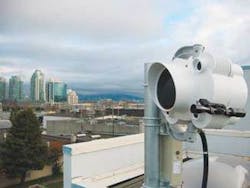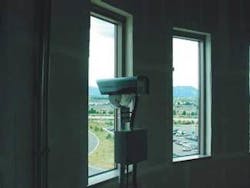Today’s laser-based free space optics have reached gigabit speeds with new features and reduced cost.
Not your typical wireless data connection, a free space optics (FSO) system is a line-of-sight technology that uses beams of light instead of radio waves to provide a point-to-point means of connectivity through the air, eliminating the need for physical fiber-optic cable. Typically run from building to building, FSO systems are deployed either as primary or backup circuits.
Since FSO technology was first developed by the military to provide secure communications to remote areas, it has been prone to environmental interferers like fog that literally can get in the way of signal transmission. At the same time, FSO systems are providing many customers with a cost-effective alternative to trenching, or paying high monthly leased-line fees.
As network speeds and uptime requirements continue to increase, many of today’s FSO system vendors have come a long way with a variety of Gigabit Ethernet solutions and new features to help maintain network availability.
Cost-effective alternative
A typical enterprise application for an FSO system is when two buildings are located within sight of each other, and trenching fiber or paying monthly leased-line fees to connect the network is either not cost-effective or possible. For example, a corporation may own two buildings separated by a physical barrier, such as water or a highway, or they may be located in a historical area where trenching is prohibited. Leased lines can cost upwards of $1,000 a month, while on the upper end of the scale, a trenching project can reach $500,000.
Because an FSO system can be set up in a matter of days, the solution has also proven invaluable for disaster-recovery situations.
“We have found that many of the FSO systems implemented during disaster recovery were almost always kept as either an integral part of the network or as a viable backup,” says Gordon Tubbs, assistant director of the Canon Broadcast and Communications Division (www.canon.com).
An FSO system features two components that receive signal via a network fiber connection. When placed within sight of each other, the two components send and receive data via a beam of light that passes through the air. While FSO systems are typically mounted on top of buildings, they can also send and receive signals through windows.
Need for speed
The first FSO systems to hit the market in the 1990s offered typical speeds of 10 to 100 Mbits/sec, which at that time were sufficient for a point-to-point connection from one building to another. But with more businesses than ever implementing Gigabit Ethernet backbones in the LAN, all vendors of FSO systems now offer Gigabit Ethernet-speed or faster solutions.
“Network speed is a function of what type of switching equipment is affordable to the enterprise,” says Isaac Kim, director of optical transport for MRV Communications, Inc. (www.mrv.com). “Now that more customers are implementing gigabit in the LAN, we’re seeing more gigabit FSO systems being sold.” MRV’s TereScope product line of FSO systems includes the TereScope 1000 series, which offers speeds up to 1.25 Gbits/sec.
fSONA (www.fsona.com) has also stepped up the data rate of their SONAbeam FSO products. “We are now shipping our 2.5 Gbit/sec product, the SONAbeam 2500-M, which is data-rate adaptive for Fast Ethernet, Gigabit Ethernet, and speeds like OC-3, OC-12, and OC-48,” says Sunny Taylor, fSONA’s president and CEO. According to Taylor, the biggest innovation with these higher-speed FSO systems is a decrease in price.
Canon’s Tubbs agrees. “The overriding emphasis has been to bring the cost down to a level where customers will be willing to pay for this technology, and the result is that our DT-130 Gigabit Ethernet product is now our biggest seller,” he says. Canon manufactures the Canobeam line of FSO products. “Back in the early ’90s, a Canobeam system was approximately $300,000. By 1999, the cost was down to $50,000. Now we have Canobeam systems available for between $14,000 and $28,000,” says Tubbs.
Even with gigabit-speed FSO solutions now available, the network industry is buzzing with discussions of 10-Gigabit Ethernet, and some end users are already running 10-Gigabit fiber backbones. But offering 10-gig FSO solutions will take vendors some time.
“Currently, our Canobeam system doesn’t compress or change the data in any way,” says Tubbs. “The goal will be how to reach 10-gigabit speeds without adding compression or manipulating the data while keeping the cost down. There’s nothing that a little time and money can’t solve, but we are not yet receiving requests for 10-gig.”
Both fSONA and MRV say they are working toward developing 10-gig FSO products so that when the market does call for it, they’ll be ready. “We have the R&D to go to higher capacities, and while we have yet to see the market push for it, I believe 10-gig will be the next jump for FSO,” says fSONA’s Taylor.
Cutting through the fog
Fiber cable has long been subject to such disturbances as imprecise backhoe use and rodents. Since its development, FSO technology has also faced several environmental challenges due to the method used to transmit information. Because FSO systems require a line-of-sight, the two points must remain free from physical obstruction. Fog, snow, and even birds can hinder the beam of light transmitted and received between the two points. While distance/range specifications vary from model to model, fog ultimately affects how far apart FSO components can be placed and still function properly.
“Fog is a portion of the product and the technology that we deal with on a daily basis, and it’s the most important specification we have to meet,” says Tubbs. “A general rule of thumb is that our Canobeam signal can travel approximately twice as far as you can see with your eyes.” According to Tubbs, whiteout snow conditions also act like fog, but FSO is not affected by rain, which does affect microwave radio signals.
“If a customer lives in an area with dense fog, that has to be considered, as well as the customer’s required availability,” says Tubbs. “Based on 10 years of visibility data taken every hour at airports throughout the U.S., we can provide a recommendation for the distance between two points for each customer’s location.” Tubbs points out that daisy-chaining FSO systems is an easy way to get around both obstacles and fog distance limitations.
“Our ClearAir M units can be spaced at 7 kilometers (km), but we have a customer that spaces them at 10 km, because they don’t ever see fog or have a need for 99.999% availability,” says Taylor. “Our system uses 1550-nm technology, which enables us to increase the power on a foggy day and still remain eye-safe.” All FSO systems are required to meet IEC Class 1M certifications for eye safety.
“While it is true that you can increase the power of 1550-nm lasers and still remain eye-safe, 1550-nm lasers require a different type of detector,” says Kim of MRV. “The sensitivity of that detector is not as good, so we feel that, basically it’s a wash. We believe that 850-nm lasers are more cost-effective. [Their] wide deployment in a variety of commercial products has reduced the price.”
According to Kim, MRV’s future 10-gig FSO solutions will likely use 1550-nm to take advantage of the technologies and electronics that have already been developed for 10-gig fiber solutions at the 1550-nm wavelength.
One way in which MRV deals with fog is to offer hybrid FSO-RF systems, which Kim says is becoming a more accepted way to implement an FSO system. “We use an 802.11g channel to offer RF backup in the case of fog taking out the signal,” says Kim. “Some customers initially believe that the RF signal won’t be able to handle their bandwidth needs, but it is a backup that kicks in so infrequently that nobody notices it.”
Up to the challenge
Building sway, seismic activity, and scintillation (rising heat) have also been known to affect alignment of the FSO beam, which can cause signal disruption. To deal with building sway and seismic activity, Canon deploys autotracking technology in their Canobeam product line, which constantly corrects the beam in the case of wind or vibrations that cause buildings to sway. “Autotracking enables the Canobeam to maintain a smaller beam of light, which is more secure and can go greater distances,” says Tubbs.
On the other hand, fSONA uses spatial diversity to deal with building sway by spacing the transceivers separate from the receiver. “We believe that autotracking is useful for the initial alignment of the beam, but we don’t rely on it for building sway because it has been found to track scintillation and lose continuity,” says Taylor. To further reduce the effects of building sway, Taylor says fSONA doesn’t recommend placing components higher than 50 stories.
Establishing signal security
Because FSO signals travel through “free space,” there has often been concern about the ability to intercept the signal. Newer FSO systems include Simple Network Management Protocol (SNMP), which lets the information-technology (IT) manager know when the signal has been interrupted, for how long, and when it was restored. If someone places another FSO receiver in such a way as to pick up the signal, the SNMP software would detect the receiver and alert the IT manager. Each vendor also provides mounting specifications to help reduce the possibility of a security breach or other problems, such as nesting birds, that can block the signal.
“Using a 1550-nm laser also helps with security issues because it cannot be seen with night vision goggles, whereas RF can be easily picked up,” says fSONA’s Taylor. “The military has chosen our system and made it very clear that the 1550-nm laser is very important for that reason.”
Traditionally, FSO systems have been targeted to the enterprise and carrier markets. When it was first developed, many believed that FSO would be the last-mile solution for carriers; however, that has not been the case.
“Most carriers are SONETbased, which is a protocol with very little error tolerance,” explains MRV’s Kim. “FSO provides small error tolerances at short distances, but at longer distances, environmental factors have the potential to cause downtime.Carriers have traditionally been slow to take on new technologies, but as they start to transition to Ethernet closer to the core, we’ll hopefully see more FSO in that market.”
To increase market acceptance, FSO vendors are working to increase awareness of these systems and their capabilities while continuing to decrease price. “Acceptance of wireless in general has grown in the market,” says fSONA’s Taylor. “Unfortunately, wireless technologies like FSO tend to get lumped into one category with RF wireless, which many people still see as insecure. The low latency of FSO is great for Voice over IP, and with 90% of buildings located over a mile away from available fiber, there’s definitely a business case for the technology.”
Focusing on even lower costs
While FSO prices have dropped dramatically over the past decade, all FSO vendors say they are working to further reduce the price. This year, Canon will move toward one standard interface for all Canobeams that will accept pluggable modules to accommodate the customers’ specific fiber interfaces. “We hope that having one standard interface will enable us to further reduce the price; plus, this approach eliminates having to decide today on your fiber interface,” says Tubbs.
Despite the drive to increase market acceptance, MRV’s Kim admits that the initial hype of FSO systems had many expecting massive amounts of revenue. “The reality is that the FSO market is only about $20 million per year,” he says. “The pie is not that big, but it is still a piece of pie.”BETSY ZIOBRON is a freelance writer and frequent contributor to Cabling Installation & Maintenance. She can be reached at: [email protected]


